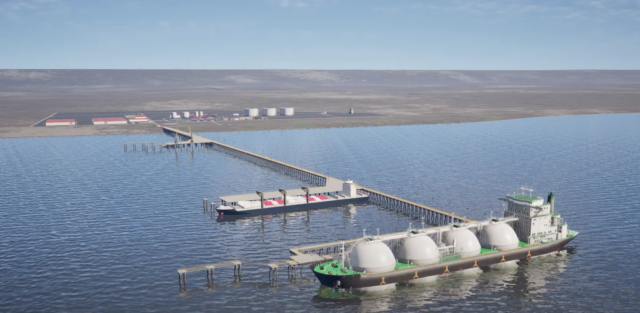AustriaEnergy: Chilean mega-project nears final approvals
By Julian Atchison on August 13, 2024
EIS submitted, approval expected late 2025

Click to learn more. Graphic visualisation of the port infrastructure for the HNH Energy project in Chile. Source: HNH Energy.
After a steady three and a half years of progress, AustriaEnergy announced that it has successfully submitted an environmental impact study (EIS) covering the first phase of its ammonia mega-project HNH Energy to the Chilean environmental authorities. AustriaEnergy expects to receive approval by late 2025, and begin construction in 2027. The $11 billion, million ton per year, wind-powered ammonia project is reportedly Chile’s largest project to ever undergo an environmental impact assessment. As with all Chilean projects under-development, the submission represents a critical milestone. Earlier this year, Mejillones Ammonia Energy in the country’s north successfully submitted their EIS for Project Volta, a 600,000 ton per year production facility based on solar power.
As a pioneer in Chile in the field of green hydrogen and green ammonia, we are very pleased that we have reached a decisive milestone with the submission of our project for environmental impact assessment – in fact for the entire Chilean hydrogen industry. The size of the project is a testament to the country’s stable regulatory framework and highly attractive renewable energy potential. We are proud to contribute to Chile becoming a leading exporter of sustainable fuels.
Managing Director of AustriaEnergy Helmut Kantner, in his organisation’s official press release, 6 Aug 2024
The first project phase includes a seawater desalination plant, one of the world’s largest onshore wind farms with a capacity of 1.4 gigawatts and 194 turbines, a process plant for converting electrical energy into green hydrogen and subsequently into green ammonia, a green ammonia interim storage facility and a multi-purpose port with a sea terminal that will also be available to other market participants. Every year, 270,000 tons of hydrogen, converted into 1.3 million tons of ammonia, will be produced. When completed, the interim storage facility will have a storage capacity of 180,000 tons per year, spread over three tanks. Construction is expected to begin in the first half of 2027 and operation in the second half of 2030.
Project details, from AustriaEnergy’s official press release, 6 Aug 2024
To expand HNH Energy, an additional 2.1 gigawatt wind farm will be added in the second phase to boost hydrogen and ammonia production capacities. An EIS for the second phase will be submitted in early 2026. FID for the whole project is expected in 2026, at which point Copenhagen Infrastructure Partners will acquire all joint venture equity shares in the project (currently, AustriaEnergy, ÖKO Wind and CIP are joint stakeholders).